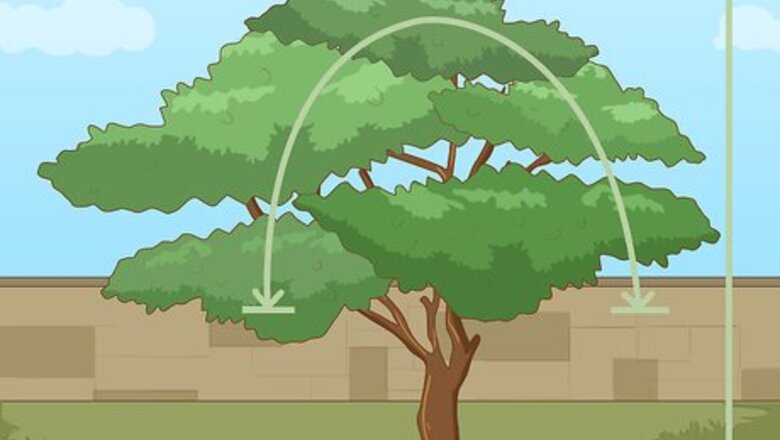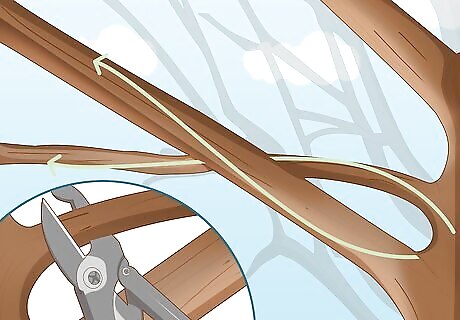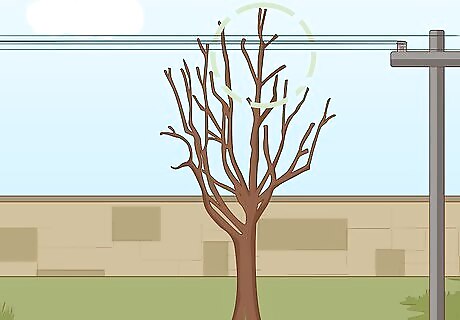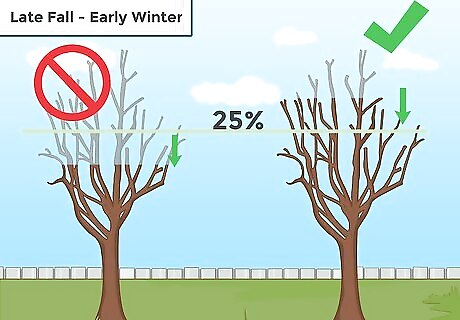
views
Deciding What to Prune

Think about why you want to prune. Are you trying to shape a tree for shade or height? Has the tree been pruned recently? Before you begin, you want to consider what you are trying to achieve and set your goals. Your reasons for pruning will influence when you prune as well. You can do light pruning or remove dead wood at any time, but if you have larger goals, you'll want to plan your pruning around the seasons. For instance, pruning in the winter will result in an explosion of growth during the spring. Pruning during the summer will slow the growth of the cut branch, so it's a good strategy if you're trying to shape your tree or slow the growth of branches you don't want.

Assess the tree. Spend a few moments looking at the tree's size and shape and imagining how it should look when you are finished.

Identify the major branches of the tree that make up its "skeleton." Avoid removal of these branches.

Remove branches that show signs of damage first. Whether they were damaged by a storm or some other event, broken branches should be pruned so that the water and nutrients they're still taking from the tree get redistributed to healthy branches.

Thin out areas that are thick with branches. Remove branches that cross, then open the plant so that air might circulate and light reach all parts of the plant. In order for trees to grow healthy, they need good air circulation through and around the branches. Branches that are close together foster the growth of fungus and attract more insects. Eliminate branches that are growing inward, toward the center of the tree. These cause clutter and are not healthy.

Prune branches that act as obstructions. Whether they're low branches blocking your walkway or higher branches threatening your telephone wires, rubbing your roof, or overhang your house. It's fine to prune the branches that are causing some type of annoyance.

Prune branches to help shape the tree. If you'd like your tree to have a more rounded or neat looking shape, prune a few branches that seem to stick out at odd angles; a few cuts will make a big difference.

Prune as little as possible. Each cut you make compromises the tree protection system and opens the tree to potential fungus and insect infestation. Prune only as much as you absolutely need to prune, and never remove more than 25 percent of a tree's branches. For most deciduous trees, make sure that there are living branches on at least 2/3 of the tree, though this varies by species. Be aware that the trunk alone is not enough to ensure that the tree will survive. Removing all the branches is highly stressful for the plant. Don't prune heavily more than once per season. Unless a storm breaks more branches, you shouldn't prune more than once, since the tree needs time to recover.
Pruning to Minimize Damage

Take out your pruning tools in the dormant season. Pruning during the late fall or early winter puts less stress on the tree, since it minimizes sap loss. Pruning during this time of year is also better for the tree because it's less likely the "wound" you make will get infected by insects or fungus, which are also relatively active in the late fall and early winter. A good time marker is to prune after the leaves have fallen off the tree. This means the tree is dormant until early spring. If a storm during a different part of the year causes a branch to break, it's OK to prune it immediately instead of waiting for winter.

Make a cut on the underside of the branch. This initial cut shouldn't go all the way through the branch. It is made to prevent the branch from cracking too close to the trunk of the tree when the weight of the branch is ready to fall. The cut should be made on the branch side of what is called the stem collar. This is the small lip of bark that each branch protrudes from. You want to leave the collar intact, so don't cut flush with the trunk.

Cut off the branch several inches from the trunk. Your second cut will saw through the branch, on the outside (further from the trunk) of the first cut you made. Remove the branch from the area; what you have left is a stub.

Make a precise cut to remove the stub. Now you can make another cut almost right against the stem collar. This gives the tree the best chance of healing in a quick, healthy way. Be sure you don't actually cut off the branch collar. This must remain intact.

Clean your pruning equipment. Although it is probably not necessary to disinfect your pruning equipment if you avoid cutting into cankers and obviously diseased portions of trees, it probably is better to be safe and disinfect your pruning tools with rubbing alcohol, a 1% bleach solution (or any household cleaner) after each cut of a diseased tree. You should also dip or rub the blades with a disinfectant impregnated cloth after the pruning of a healthy tree is complete, and be especially thorough before you move to the next tree or bush. Diseases are sometimes spread through dirty pruning equipment and pruning tools.




















Comments
0 comment